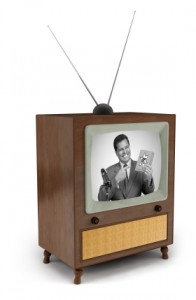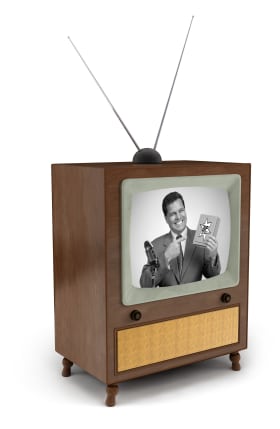In 1950, when TV was in its infancy, in the entire United States only 170 persons under the age of fifteen were arrested for serious crimes such as murder, rape, robbery, and aggravated assault.
By 1979 the rate of serious crime committed by children under fifteen had increased by 11,000 percent.
— Myriam Miedzian, Boys Will be Boys
 When my son was five years old, I think he believed that if he watched too much TV, he would have brains that look like oatmeal. That’s the only visual image he had for “mush.” Yes, I sometimes would answer in exasperation to the many “Why?”s I got when enforcing our TV watching rules, “Because TV turns your brains to mush!”
When my son was five years old, I think he believed that if he watched too much TV, he would have brains that look like oatmeal. That’s the only visual image he had for “mush.” Yes, I sometimes would answer in exasperation to the many “Why?”s I got when enforcing our TV watching rules, “Because TV turns your brains to mush!”
Actually, that’s not far from the figurative. Four-, five-, or six-year-old children are not able, developmentally, to understand that their brain is being conditioned by media messages. At some level, they can begin to understand that TV teaches them something.
We live in an age of media overload and it’s important that we recognize and monitor what our children are exposed to, so that we can help them to understand what is “real” and what is not. Also, we need to know what they are watching, so that we can teach them to “think” about, and question, what they see in the media.
Here are a few very clear things that we can do, as parents and teachers, to affect the media’s impact on our culture and young children.
Discuss what they see on TV and in the media with your children
Take the time to discuss with children, at a level they can understand, the effect that TV shows can have on them.
I used to say to my children, “When you watch Mr. Roger’s, you learn about people and the jobs they do. What else do you learn?” or “TV teaches you about … (fill in with something positive that is very concrete to them, such as ABC’s, counting, etc.). When you watch Power Rangers, or VR Troupers, you are learning also. How do Power Rangers solve their problems? (Most children will answer: “Fighting or they beat up the bad guys.”) This show is teaching you to solve problems by fighting.” This is an important conversation to have. Variations of this conversation need to happen regularly.
Help Your Children Understand the Difference Between Reality and Fantasy
 It is important to help children understand that, on TV, a person can get kicked ten times and can then get up, but in real life, getting kicked hurts. In addition, discuss with children ways that superheroes can solve problems without violence.
It is important to help children understand that, on TV, a person can get kicked ten times and can then get up, but in real life, getting kicked hurts. In addition, discuss with children ways that superheroes can solve problems without violence.
Living in a society saturated by violent images, parents have a difficult road to follow if they are going to take a stand against media violence. Somehow, a balance needs to be achieved. If we completely deprive our children of all media violence, we worry that they will eventually rebel against our standards, making violence a steady diet, or will feel that they don’t fit in with their friends.
A moderate path would be to carefully choose the shows that your child is allowed to watch. Monitor the amount of time your child watches those shows. Watch with your child. Discuss the values, lessons, and methods of problem-solving that they seen in a show. Discuss what is real and what isn’t. Discuss the real life consequences of behavior modeled on the television show.
In the classroom, teachers can take an interest in their students’ favorite shows. Discuss the shows with your students to help them understand what is real and what isn’t. Help them to employ alternatives to violence in their own play.
Teach Your Children Empathy
The single most important thing that parents and educators can do for preschoolers to limit negative effects caused by violence in the media is to teach them empathy. Preschoolers cannot see another person’s point of view. To require three- through five-year-olds to see someone else’s point of view is developmentally inappropriate. Preschoolers can feel empathy. Empathy needs encouragement to flourish. Here are some examples of how to encourage empathy:
• Allow children to talk about their emotions
• Notice a child sharing or showing concern for others
• Hold class or family meetings where relationships and feelings can be discussed openly
New scientific studies and advanced technology have taken our understand ing of how the environment affects us beyond the psychological foundations of conditioning: “People, including children, tend to develop a taste for what they are conditioned to. There is no indication that in the 1950’s boys enjoyed TV less because it was less violent…. It is an acquired taste that the media have played an important role in developing.” The National Institute of Mental Health published a report in 1982 which confirms that “children who watch a lot of violence on television may come to accept violence as normal behavior”
— Myriam Miedzian, Boys Will be Boys
Take the time to discuss with children, on a level they can understand, the effect that TV shows and commercials have on them. I engage children in a conversation about their favorite TV shows. We discuss the characters: What ‘color’ are they? Are they dark or light? Which characters are dark? Which characters are light? What might this be teaching us to think about people who are dark-skinned or light-skinned? Are they male or female? What are the males like? What are the females like? What are these characters teaching us about how boys should act? How girls should act? Are the characters peaceful? Violent? Kind? Cooperative, etc.? How do the characters in the shows solve their problems? Are there other ways to solve problems? Discuss with children ways that superheroes can solve problems without violence. Help them to understand that, on TV, a person can get kicked ten times and can then get up, but that in real life, getting kicked hurts, and sometimes people are hurt badly enough that they don’t get up. Discourage war play centered on media superheroes such as Power Rangers and Ninja Turtles.
Help children to see alternatives to violence in their own play. If they are using media superheroes in their play help them to create alternative means of handling ‘the bad guy,’ encourage them to question if violence is the only way to defeat the villain.
Excerpted from Free The Children, Conflict Education for Strong Peaceful Minds by Susan Gingras Fitzell.
Media-Smart Youth: The Power of Advertising
The violence that our youth are subjected to in so many television shows is only one area of concern. Another issue, and one that is much more difficult for young children to understand, is advertising.
This video discusses the influence of advertising and its connection to health. The video shows an array of common advertisements in various forms.


